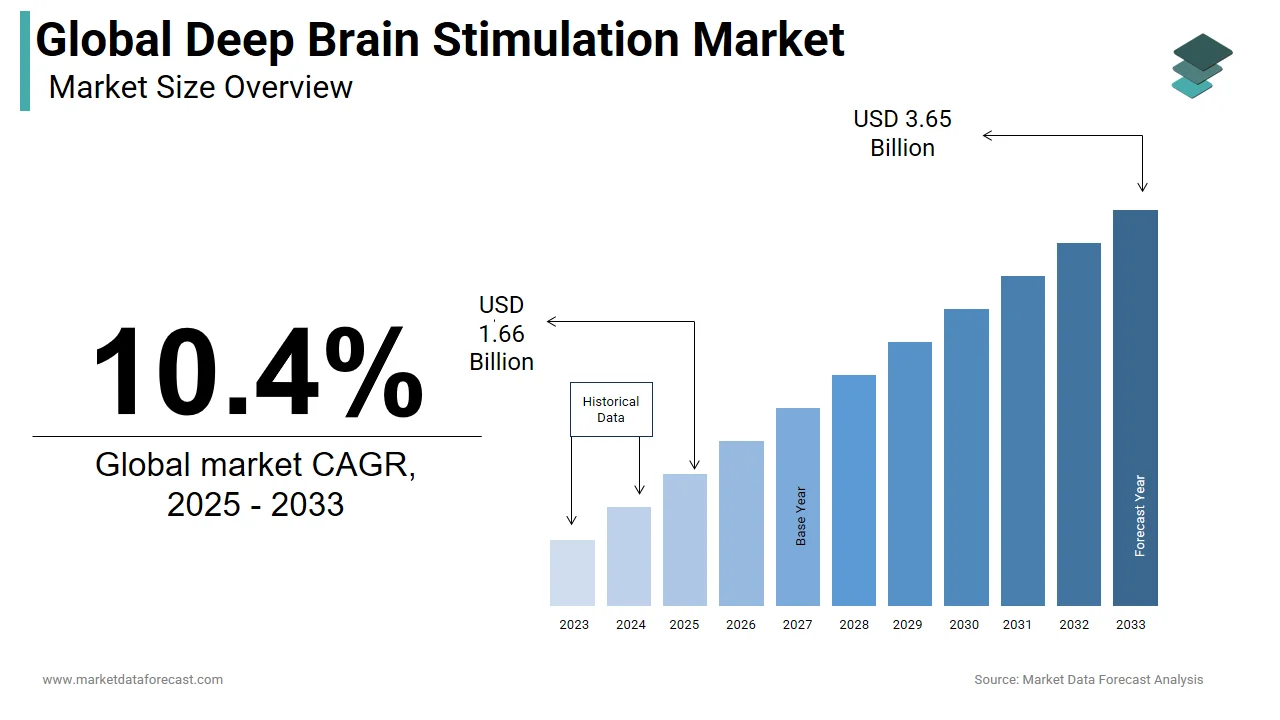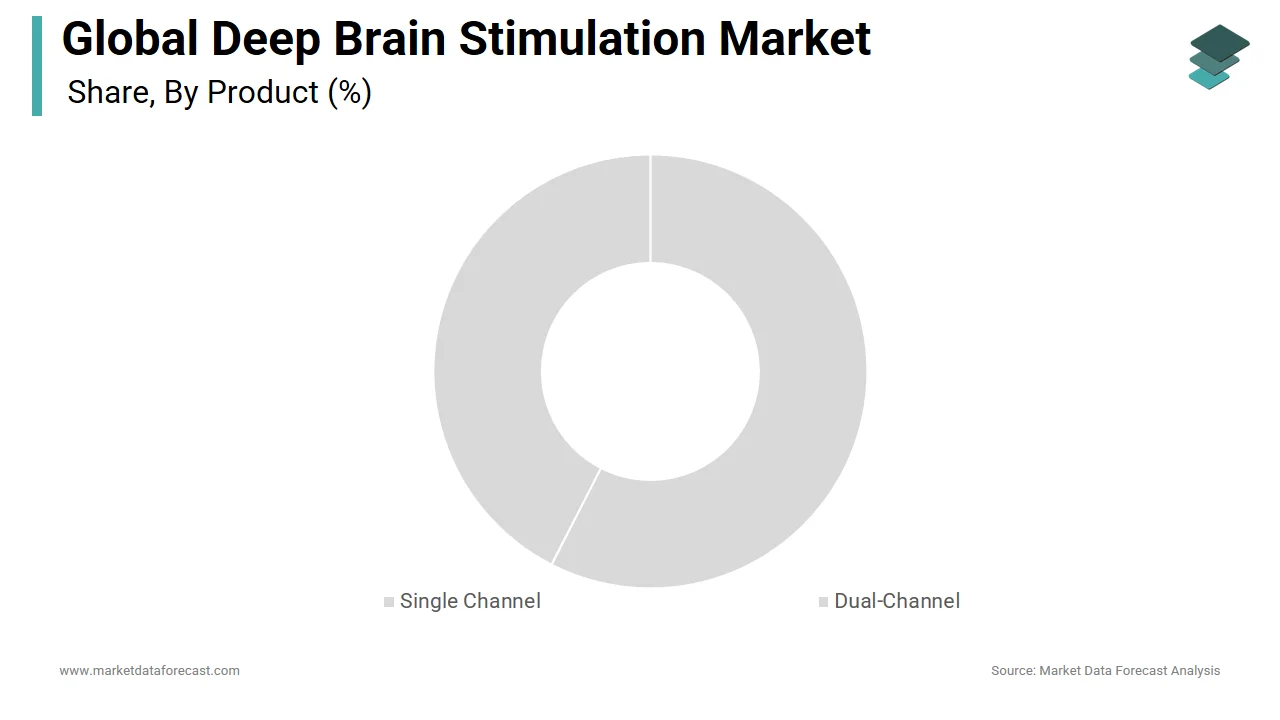Global Deep Brain Stimulation Market Size, Share, Trends & Growth Forecast Report By Product, Type, Application, End-Use and Region (North America, Europe, Asia-Pacific, Latin America, Middle East and Africa), Industry Analysis From 2025 To 2033.
Global Deep Brain Stimulation Market Size
The size of the global deep brain stimulation market was worth USD 1.5 billion in 2024. The global market is anticipated to grow at a CAGR of 10.4% from 2025 to 2033 and be worth USD 3.65 billion by 2033 from USD 1.66 billion in 2025.

The human brain functions via thousands of brain cells called neurons. The neurons work and communicate, and perform functions by releasing small electrical charges between them. When these electric charges are not adequately released or communicated, we suffer from various diseases and mental conditions. The deep brain stimulator (DBS) is a treatment procedure through which the electrical impulses in the brain are externally stimulated by connecting devices that deliver direct electrical current to the parts of your brain where it is required.
One or more wires are attached to a small device, which is then attached to the patient near the collarbone area and delivers mild electric currents to the regions of the brain that require it. DBS can treat several conditions of the brain, like epilepsy, dystonia, Parkinson's disease, essential tremors, obsessive-compulsive disorder (OCD), etc. The procedure can also help in various conditions like Alzheimer's, anxiety, headaches, schizophrenia, etc.
MARKET DRIVERS
Technological Advancements Drive Growth
The increasing need for minimally invasive techniques in treating mental disorders, along with elevated patient outcomes, is driving the deep brain stimulation market growth. The deep brain stimulation market is expected to progress due to the rising technological advancements, research, and developments worldwide. For instance, improved microelectrode designs, rechargeable implantable pulse generators, personalized directed programming, robot-assisted implantation, and others make the DBS treatment system preferable over other drug treatments. On the other hand, the side effects of drug treatments can leave a lasting impact on the patients. For instance, the continuous dosage of a drug called levodopa may result in dyskinesia and hallucinations. Additionally, a rise in awareness about the DBS treatment, a targeted system with a lower risk of side effects, and a long-term solution to brain disorders on the market, is expected to witness market development.
Growing FDA Approvals and Rising Mental Disorders Fuel Growth
The growing number of FDA approvals, Y-O-Y rise in the geriatric population worldwide, and increased rate of mental disorders and conditions fuel deep brain stimulation market growth. The increased cases of mental conditions and patients suffering from Parkinson's disease, dystonia, multiple sclerosis, and many other involuntary movements are leading the market towards progress. Neurological disorders contribute around 6.3% to the global disease burden, and it has become one of the significant causes of mortality around the world, accounting for about 13.2% of deaths in developed countries and 16.8% in middle and low-income countries, according to WHO statistics.
MARKET RESTRAINTS
High Costs and Stringent Guidelines Hinder Growth
The high costs of treatment in deep brain stimulation and the stringent guidelines during approval by the FDA, various difficulties faced during the clinical trials, manufacturing, and production due to limited expertise in the field and a lack of skilled professionals, and unfavorable reimbursement policies are expected to hinder the growth of the deep brain stimulation market.
REPORT COVERAGE
|
REPORT METRIC |
DETAILS |
|
Market Size Available |
2024 to 2033 |
|
Base Year |
2024 |
|
Forecast Period |
2025 to 2033 |
|
Segments Covered |
By Product, Type, Application, End-Use, and Country. |
|
Various Analyses Covered |
Global, Regional and Country-Level Analysis, Segment-Level Analysis, Drivers, Restraints, Opportunities, Challenges; PESTLE Analysis; Porter’s Five Forces Analysis, Competitive Landscape, Analyst Overview of Investment Opportunities |
|
Regions Covered |
North America, Europe, Asia Pacific, Latin America, Middle East & Africa |
|
Market Leaders Profiled |
Neuropace, Synapse Biomedical Inc., MicroTransponder Inc., Aleva Neurotherapeutics SA, NeuroSigma, Medtronic, Boston Scientific Corporation, Cyberonics Inc., Nervo Corp., Cyberonics Inc., Zynex Medical, Functional Neuromodulation Ltd., Abbott, and Reshape Lifesciences Inc.. |
SEGMENT ANALYSIS
By Product Insights

Based on the product, the dual-channel segment dominated the deep brain stimulation market in 2022 with a share of 54.22% due to the high usage of the segment in surgeries and requirements for PD surgical procedures. In addition, the technological advancements in the segment enabled it to be used by multiple hospitals, thus its dominance.
However, the single-channel segment is expected to grow at a healthy CAGR during the forecast period because healthcare professionals believe it provides more programming options. Thus, the preference for the single-channel has propelled and is estimated to grow during the forecast period.
By Type Insights
By type, the subthalamic DBS segment is predicted to lead the global deep brain stimulation market during the forecast period. Growing government support and raising awareness over the availability of different techniques in healthcare are leveling up the market's growth.
The globus pallidus DBS segment is growing at a higher rate in the coming years.
By Application Insights
Based on the application, the Parkinson’s disease segment accounted for a 61.8% share in the global deep brain stimulation market in 2022, owing to the increased FDA approvals of the DBS therapies for PD in the U.S and the increased cases of PD worldwide. In addition, there is growing awareness about the advanced treatment of epilepsy and development in the healthcare and infrastructure, consequently leading to the segment's growth during the forecast period.
By End-Use Insights
Based on the end-user, the hospital segment registered a share of 53.3% in the global deep brain stimulation market in 2022, and the dominance of this segment is anticipated to continue throughout the forecast period due to the technological advancement and increased number of surgeries performed in hospitals, along with rising cases of PD and favorable reimbursement.
However, the ambulatory surgical centers segment is expected to develop at a significant CAGR during the forecast period due to lower costs than hospitals, better patient care, and lower risk of infections.
REGIONAL ANALYSIS

Geographically, the North American region led the deep brain stimulation market worldwide in 2024 and is expected to continue to dominate during the forecast period due to the presence of key market players in the region, along with increased government initiatives and support, and increased FDA approvals in countries like the U.S. and Canada. For example, the MRI labeling RNS system of the NeuroPace was approved by the U.S FDA in March 2020. Moreover, increased cases of psychiatric disorders in the U.S and Canada will lead the market to grow in the region.
Asia-Pacific is also expected to contribute significantly to the global deep brain stimulation market during the forecast period due to the increased awareness about neurological disease treatment options, rising cases of neurodegenerative disorders, and a need for long-term solutions that will lead the market to grow. Furthermore, with the establishment of organizations in countries like India, China, Japan, South Korea, and others, the market is predicted to prosper in this region. For instance, the past three years have seen significant growth in the number of DBS centers in China, with more than 200 DBS leads being implanted yearly.
KEY MARKET PLAYERS
Some of the prominent players operating in the deep brain stimulation market and profiled in this report are Neuropace, Synapse Biomedical Inc., MicroTransponder Inc., Aleva Neurotherapeutics SA, NeuroSigma, Medtronic, Boston Scientific Corporation, Cyberonics Inc., Nervo Corp., Cyberonics Inc., Zynex Medical, Functional Neuromodulation Ltd., Abbott, and Reshape Lifesciences Inc.
KEY MARKET DEVELOPMENTS
- In 2019, Teijin Limited (Teijin) and NeuroSigma agreed to collaborate. (From Japan) Teijin Pharma, Teijin's healthcare business's core division, has been granted exclusive rights to market NeuroSigma's Monarch eTNS product in Japan and the company's TNS patent rights for the non-invasive treatment of ADHD.
- In 2018, Abbott and the National Institutes of Health (NIH) signed a deal. (United States). According to the agreement, Abbott will donate neuromodulation instruments, such as lateral DBS, SCS, and DRG treatment, to the NIH for research into their applications in chronic pain and progressive movement disorders.
- In 2017, Medtronic and Mercy (US) partnered to form a virtual data sharing and testing network to help collect scientific data for medical device innovation and patient access.
MARKET SEGMENTATION
This global deep brain stimulation market research report is segmented and sub-segmented into the following categories.
By Product
- Single Channel
- Dual-Channel
By Type
- Subthalamic DBS
- Globus Pallidus DBS
- Thalamic DBS
- Pedunculopontine Nucleus DBS
By Application
- Pain Management
- Epilepsy
- Essential Tremor
- Obsessive-Compulsive Disorder (OCD)
- Depression
- Dystonia
- Parkinson’s Disease
- Others
By End-Use
- Hospitals
- Neurology Clinics
- Ambulatory Surgical Centres
- Research Centres
By Region
- North America
- Europe
- Asia Pacific
- Latin America
- Middle East and Africa
Frequently Asked Questions
1. What is the growth rate of the global deep brain stimulation market?
COVID-19 impacted the deep brain stimulation market negatively. The detailed analysis of COVID-19 on deep brain stimulation market is included in this report, Request the sample brochure of the report for more information.
2. Who are the key players in the deep brain stimulation market?
The global deep brain stimulation market is projected to witness a CAGR of 10.5% from 2025 to 2033.
Related Reports
Access the study in MULTIPLE FORMATS
Purchase options starting from
$ 2500
Didn’t find what you’re looking for?
TALK TO OUR ANALYST TEAM
Need something within your budget?
NO WORRIES! WE GOT YOU COVERED!
Call us on: +1 888 702 9696 (U.S Toll Free)
Write to us: sales@marketdataforecast.com
